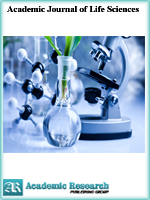Academic Journal of Life Sciences
Online ISSN: 2415-2137
Print ISSN: 2415-5217
Print ISSN: 2415-5217
Quarterly Published (4 Issues Per Year)

Archives
Volume 2 Number 12 December 2016
Determinations of Some Selected Heavy Metals and Elements in Baobab Tree Leaves (Adonsonia digitata) Grown in College of Agriculture, Maiduguri, North ? Eastern Nigeria
Authors: Gwana Adamu Mohammed ; Effiong Edet Bassey ; Muhammed Alhaji Bashir ; Buhari Bagudu Yawuri ; Shetima Usman Kyari ; Abubakar Musa ; Bukar M. Bukar
Pages: 89-95
Abstract
This research study was carried out on the appraisal of some selected heavy metals and elements in Baobab tree leaves (Adonsonia digitata) grown in College of Agriculture, Maiduguri, north – eastern Nigeria. The samples were collected, authenticated and prepared as described by Gwana, et al. [1]. Plant part materials were analysed in triplicate and the techniques applied were that of the methods as described by AOAC (Association of Official Analytical Chemists) [2] and Ashiq, et al. [5]. The results obtained revealed that the presence of the seven selected metals and elements with their mean concentration levels were ranged from 0.3 to 81.0 mg / l; 81 mg / l, 0.84 mg / l, 0.04 mg / l, 0.61 mg / l, 0.68 mg / l, 0.3 mg / l, and 0.3 mg / l for Ca, Cd, Cr, K, Mn, Pb and Zn. While with regard to the mean percentage of their concentration were ranged from 0.4 % to 97.0 %; Ca had 97.0 %, Cd (1.0 %), Cr (0.05 %), K (0.73 %), Mn (0.81 %), Pb and Zn both had 0.4 % each. The magnitude of concentration levels of the elements detected in Adonsonia digitata leaves in sequential order was Ca > Cd > Mn > K > Pb and Zn > Cr, the highest mean concentration was calcium (Ca), the least was chromium. Adonsonia digitata leaves grown in this area were rich in minerals, both macro and micro elements. The study also revealed that amongst the seven elements being determined, Ca, Cd and Cr had exceeded the standard recommended values for heavy metals and elements, both rest (Mn, K, Pb and Zn) were found not health risks free, wholesome for consumption (in terms of the minerals determined) by human beings and animals. The results obtained were similar to the works of Ibrahim and Jimoh [7], Qais, et al. [9]; Okoronko, et al. [15] amongst others.



